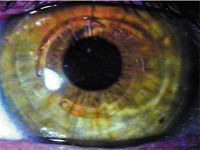Article
Intrastromal ring segments promising for keratectasia
Santiago, Chile-Intracorneal Ferrara rings (Mediphacos) appear to be a useful alternative method to improve corneal shape and best-corrected visual acuity (BCVA) in patients with keratectasia. However, the long-term refractive effects and complications of the rings need further study, according to Marcelo Coria, MD.

Dr. Coria and colleagues conducted a study in which they evaluated the clinical and topographic outcomes and the complications that developed in patients who received the intrastromal Ferrara ring segments for the treatment of primary corneal ectasia, such as keratoconus and pellucid marginal degeneration.
The corneal ring segments were implanted in 16 eyes of 14 patients (10 men, 4 women).
The patients received ring segments that were 150, 200, 250, 300, and 350 μm.
The investigators recorded the visual acuity level, refraction, and corneal topography. Orbscan topography (Bausch & Lomb) was used to assess the corneal shape. The examination also included an evaluation of the posterior and anterior segments.
Dr. Coria described the surgical technique.

"At the end of the follow-up period, the mean BCVA improved by three lines of vision," Dr. Coria reported. "The best results were seen in the group of patients who received the 150-μm ring segments. These patients had a mean improvement of five lines of visual acuity. In the patients who received the 300- and 350-μm segments, the mean improvement of the BCVA was two lines and this remained stable during the follow-up period."
The mean SE decreased about 5 D from –8.0 to –3.5 D.
"We found that the most important changes occurred in association with the thickest ring segment," Dr. Coria said. The cornea flattened by a mean of about 2 D. The thicker the rings were, the greater the flattening of the corneal curvature. In the group with the thickest ring, the cornea flattened by more than 10 D.
Three cases required explantation of the rings because either the ring was implanted too superficially or it was implanted too close to the incision.
Superficial keratitis developed in six cases, related to contact lens fitting.
"From our results, we can infer that the intrastromal Ferrara ring segments are an efficient and reversible method to treat primary keratectasia. The technique improved the BCVA and improved the fit of the contact lenses. The surgical technique requires mastering a learning curve in order to obtain good results. The complications in our cases were related to superficial implantation of the ring segments near the incision," Dr. Coria concluded.
Newsletter
Don’t miss out—get Ophthalmology Times updates on the latest clinical advancements and expert interviews, straight to your inbox.





.png&w=3840&q=75)















